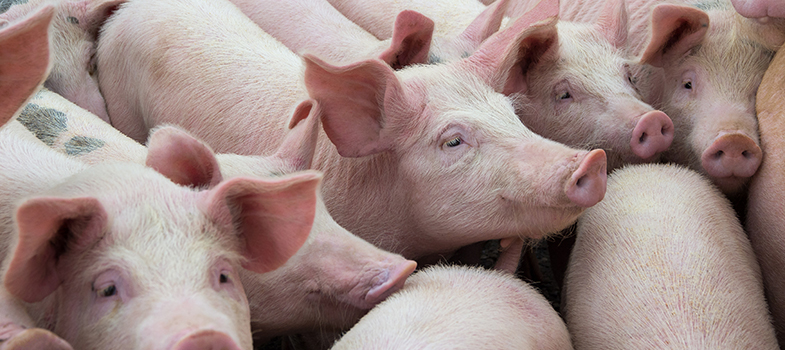4.4 Antimicrobial residue data
Carcasses and animal products (such as milk samples) can also be tested for the presence of antimicrobial residues. Residue data can also be collected using samples from abattoirs, domestic markets and processing plants. Environmental samples such as wastewater from a broiler farm could also be useful for residue testing.
Match the following specific benefits to either AMU surveillance and reporting, or data on resistant bacteria.
‘Allows patterns of AMU to be identified.’
a.
AMU surveillance and reporting
b.
Data on resistant bacteria
The correct answer is a.
‘Allows comparison with AMR patterns in humans to analyse possible transmission.’
a.
AMU surveillance and reporting
b.
Data on resistant bacteria
The correct answer is b.
‘Informs decision-making for the effective treatment of unwell animals.’
a.
AMU surveillance and reporting
b.
Data on resistant bacteria
The correct answer is b.
‘Provides a baseline allowing targets to be set to reduce AMU.’
a.
AMU surveillance and reporting
b.
Data on resistant bacteria
The correct answer is a.
Explain the benefits of testing bacteria from asymptomatic animals for AMR – perhaps using a specific context, such as a broiler unit.
Testing healthy animals can identify the presence of resistant commensal bacteria, which can be transmitted to humans and to the environment. This information can inform the choice of antimicrobial used for animals in that setting in future. It can also allow targeting of strategies to tackle AMR, for example, targeting reduction of use of a particular antimicrobial. Changes in resistant bacteria in asymptomatic animals over time can reflect the effectiveness of strategies to tackle AMR.
Activity 8: Data on resistant bacteria in your setting
Return to the diagram of an animal production system you used in Activity 5 to answer the following questions:
- Choose at least three points in the system that could be useful sources to investigate the presence of resistant bacteria using the types of testing described in Section 4.3.
- For each example, mention the purpose of the data you have chosen – that is, how that information could be used. Examples of different purposes would include:
- guiding the treatment of sick animals
- investigating the presence of resistant commensal bacteria
- investigating transmission of resistant bacteria between different parts of the system.
- For each one, choose the specific sample you would send to the laboratory for testing. Assume that all samples will be cultured to isolate the target bacteria. Genotypic techniques would then be used to identify the presence of resistance genes and to compare strains found in different sources.
We have provided a blank table template [Tip: hold Ctrl and click a link to open it in a new tab. (Hide tip)] for you to complete your plan. The template includes an example from the production system example in Figure 11 as a guide. Add at least three examples from your own setting. We have provided two extra rows for any further examples that you would like to add; if you like, you could add more rows (or continue on paper) if you have additional examples.
Discussion
Your answer will be specific to your setting. Table 2 includes three examples based on the production system shown in Figure 11. (Revisit Section 4.3 if you need to revise this topic.)
| Name | Source | Purpose | Sample |
|---|---|---|---|
| Our example | Healthy broilers from the broiler farm | To monitor the emergence of resistance, especially in commensal bacteria | Faeces from the broiler shed |
| Our example 1 | Pond water and sediments from the aquaculture ponds | To establish the presence of resistant bacteria and compare with the data from broilers to investigate possible transmission | Water and sediment samples |
| Our example 2 | Animal feed | To check whether the feed is contaminated with resistant bacteria | The broiler feed provided by the feed company |
| Our example 3 | Sick fish from an aquaculture pond where some fish have died | To confirm whether pathogenic bacterial infection is present and to guide choice of antimicrobial | Organs from fish carcass(es) |
| Extra example | The environment | To establish the presence of resistant bacteria | Abattoir wastewater samples |
| Extra example |
Activity 9: Benefits of coordinated testing for resistant bacteria
Look at the table you created in Activity 8 about data on resistant bacteria. Explain why all three (or more) sources of data are more useful than just one of your examples.
Discussion
Your response will be specific to your setting. Based on our example table, we could have chosen to suggest the following:
- Testing sick or dead fish helps to guide treatment, but on its own does not allow analysis of transmission of AMR in the system.
- Testing both broilers and pondwater allows comparisons of resistant strains in both parts of the system.
- If the same resistant strains are found in broiler feed and in the healthy broilers, the feed may be an important source of resistant bacteria in the broilers, which could be addressed by improving hygiene in the animal feed process.
- Comparing resistant bacteria in abattoir wastewater and in fish farm samples such as pondwater could help to demonstrate transmission of resistant bacteria from the environment to aquaculture ponds via contaminated water sources. Molecular techniques could be useful here.
4.3 Data on resistant bacteria



